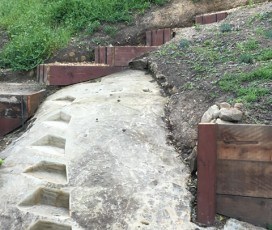Since the start of rainy season I have noticed many hillsides tarped off in our county. This is not a good sign as it is usually a last resort to cover the ground with tarps to prevent it from absorbing more water and sliding. It is always best to take preventative measures ahead of time. To help you safeguard your property here are some tips, take them seriously.
Hillsides are affected by gravity 24 hours a day seven days a week. Add water to that gravity and you can be in for real trouble and sometimes under the right conditions loose your property and home. What can you do ?
First divert water away from the hillside. Rain water naturally flows downhill in the gullies it creates. When possible divert water into new trenches that take it away from the hillside. When possible divert rainwater into 4inch solid poly pipe [ underground ] making sure the outlet is downhill and away from the hillside face. Drain water away from the hillside anyway you can, do your work in the Summer way before the rainy season and take your time, do not cut corners.
Plant your hillside with English Ivy or better. During the Summer dig small planting holes all over the hillside. After you are done spread 6 inches of quality top soil over the entire hill. Next install a copper and brass sprinkler system. Copper pipe with brass sprinkler heads are bullet proof and child resistant and will last forever. If you keep the ivy watered it will over grow the hillside in no time rooting in deeply holding the hill in place. Most land movement starts with erosion and soil sloughing, as it gets worse this can lead to major earth movement. Usually good drainage and plantings will keep your hill from moving if it still shows signs of erosion it will be necessary to be more aggressive with hill holding measures.
OK your hill is showing erosion what to do. Retaining walls and erosion control systems. Retaining walls are expensive and do the job if the hill is really steep. I have covered them with content in the retaining wall section of this site, check in Retaining walls.
The other option is to install a steel mesh system to hold the soil in place and prevent erosion from getting a foot hold.
What is an erosion control mesh system ?
Many times I have seen hillsides failing. If the erosion is not stopped somehow the hill will eventually slide, at minimum making one big mess. Here is what I engineered to stop major erosion in is tracks. This design has worked every time without failure thus far.
- Outline the border of the area to be retained with long nail spikes, one every 3 feet or so
- Buy enough 4 foot foundation stakes to cover this area one stake for every 6 square feet. Drive them all the way in if possible and keep them lined up with the other stakes. Cut off the extra stake if necessary 2 inches off the soil. Later you will be attaching rebar to these stakes to hold in place the hill holding steel mesh
- Buy enough 4inch by 4inch galvanised structural mesh to cover this area plus 10 percent extra [ 6 gauge ]
- Buy enough small galvanised mesh to cover this area twice. Plastics are OK but rats like to eat plastic
- Buy enough 5/8s inch rebar to connect to all the stakes plus some extra
- Place two layers of small galvanised mesh over entire area
- Place one layer of heavy mesh over small mesh
- Place 5/8 rebar between all foundation stake tops and over the heavy mesh
- Connect the rebar to the stakes with #8 solid copper wire [ twist connect it, the wire will hold the rebar to the foundation stake tops ]
- Spray paint the mesh flat brown
- Check all connections and you are done
This mesh retention system will not fail for erosion control unless the whole hill fails very deep down. If the hill is failing deep it will show up in large cracks that look scary. If you see large cracking it is best to call a soils engineer ASAP.
I have used this system for years for heavy erosion control and have had no call backs. This is a good sign – Dave Mason 12/4/19
David Mason Marin Restorations 1-415-297-1489 #715338
























